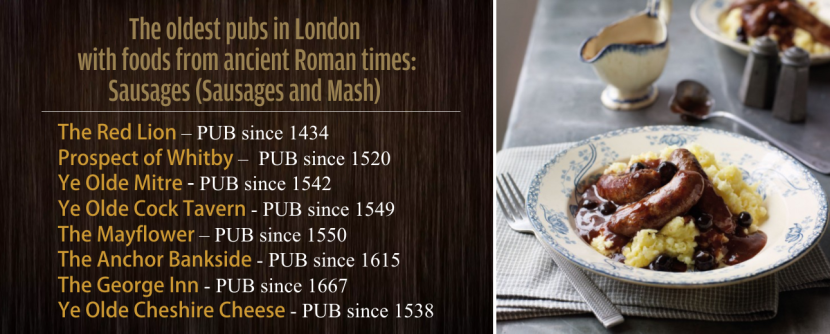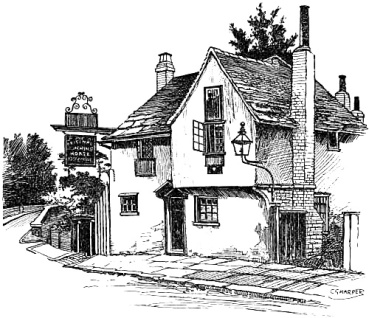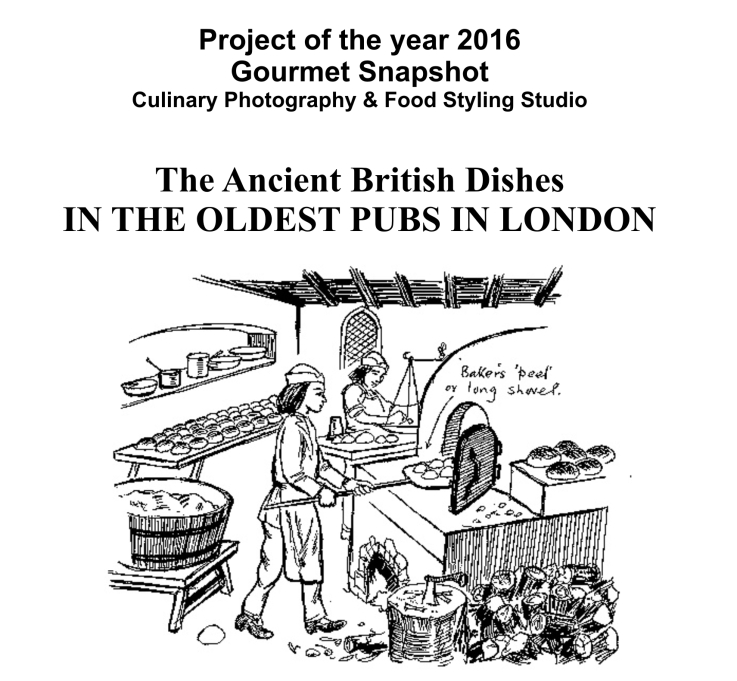
Because the Gourmet Snapshot is a studio of Culinary Photography and Food Styling, this project aims to rediscover the Ancient British Dishes in the oldest pubs in London. We also wanted to find out if these kinds of dishes, can be found today in the oldest pubs in London.
I
A BRIEF REVIEW OF THE PUBS IN LONDON
With a few several hundred years ago …………………

The origin of pubs can be traced back to the Roman colonization of Britain, when inns and ‘tabernae‘ were first established along Roman roads. Before being known as pubs, these locations were called Tabernae. (A type of shop in Ancient Rome) [Etymology Word : Latin. By dissimilation from *traberna, from trabs.]
The Taberna was a “retail unit” within the Roman Empire and furthermore was where many economic activities and many service industries were provided, including the sale of cooked food, wine and bread.
within the Roman Empire and furthermore was where many economic activities and many service industries were provided, including the sale of cooked food, wine and bread.
Also, the Tabernae were built to serve food and wine to travelers. These Tabernae evolved into Alehouses, Inns, Taverns and Pubs
These taverns or alehouses not only survived but continued to adapt to an ever changing clientele.
THE DIFFERENCES BETWEEN ALEHOUSE, INNS,TAVERNS AND PUBS
Pubs, Inns, Alehouses and Taverns are an ever present element of English villages, towns and cities. By 1577 it is estimated that there were some 17,000 alehouses, 2,000 inns and 400 taverns throughout England and Wales. Taking into account the population of the period, that would equate to around one pub for every 200 persons. To put that into context, that same ratio today would be approximately one pub for every 1,000 persons

Pubs, Inns, Alehouses and Taverns, most of the times we use these words interchangeably but they mean different places.
ALEHOUSES
Were common from the Middle Ages. Most households brewed ale, some brewed more than they could drink and some brewed better ale than others; these could sell their ale from their houses! Richard II decreed that those selling beer had to advertise it via ale stakes which were later converted to pub signs. Later on commercial “houses” were created and many remained in use until the early C20th Century.
INNS
Appeared in England in the twelfth and thirteenth centuries, and were apparently fairly common, especially in towns, by the fifteenth century. Inns were larger institutions where travellers could stay overnight and be fed whilst their horses were stabled. Chaucer’s pilgrims started their journey in an inn. Plusher, more expensive though with communal sleeping areas for most guests, an inn was a cut above an ale house. Noblemen/women could eat/sleep in their own rooms thus avoiding the dormitory misery of their fellow guests. The heyday of inns was from 1663 when Turnpike Acts made roads more navigable and mid C 19th when railways allowed people to complete their travel in one day.
TAVERNS
Have been present in Britain since Roman times when they were called Taberna. Selling wine as opposed to ale, often to those who had travelled and usually located in towns, taverns were frequented by the upper classes whereas working people (mostly men) would be drinking at the ale house. They were most popular between the Middle Ages and late 18th Century, their popularity declining as wine became more easily available.
Now we use the term public house, or “pub” to describe all three establishments though class has always been an important element in determining where one drank. Until recently this was maintained through separate public bars and saloons in the same building
The word ‘pub’ derives from ‘public house’, first used in the 18th century and in common usage by Victorian times, when strict licensing laws were introduced to monitor the sale and consumption of alcohol.
For centuries, London’s pubs have served as meeting places, social spaces, rooms to relax and unwind, places to talk business, to eat and drink, to find comfort for an evening or solace for an hour.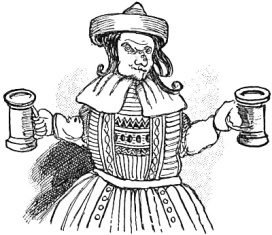
Pubs have been at the center of British culture for centuries, and the writer Samuel Pepys himself, describing them as the heart of England. London pubs are brimful of history, many of their names reflecting either an historic event or personage.
Pubs serve two distinct but intimately entwined functions – to sell drinks and to enable people to meet. In the British pub many customers are eager to chat with the other occupants, even complete strangers. Pubs are often the centre of community life – in towns and cities as well as villages – and play a huge role when it comes to social cohesion.
From the 1810”s we find purpose-built public houses, starting in London and the larger provincial towns. The number of pubs grew with the population. The late Victorian era saw the creation of flamboyant pub interiors, notable for their sumptuously decorated mirrors, tiled walls and etched glass.
II
THE PUBS SELECTED FOR THIS PROJECT
For this project we have selected the period from 1400 to 1700.
We believe that this period, it is a significant and unique period in the evolution of the British Pubs and of the Ancient British Recipes. We have selected the 13th pubs in London. These pubs are some of the oldest pubs of London and also are a part of the England History:
1. The Cittie of Yorke – since 1420
2. The Red Lion – since 143
3. Prospect of Whitby – since 1520
4. Ye Olde Cheshire Cheese – since 1538
5. Ye Olde Mitre -since 1542
6. Ye Olde Cock Tavern -since 1549
7. The Mayflower – since 1550
8. The Grapes – since 1583
9. The Spaniards Inn – since 1585
10. The Seven Stars – since 1602
11. The Kings Arms (Oxford St.) – since 1607
12. The Anchor (Bankside) – Since 1615
13. The George Inn – since 1667
III
A BRIEF HISTORY OF THE FOOD PREPARATIONS OF THE OLDEST PUBS IN LONDON
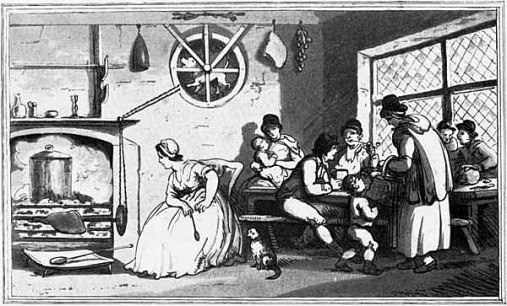
Delve back into history, between 1400 and 1700 in the London pubs we could find the following dishes:
NETTLE SOUP
Nettle Soup is a traditional soup prepared from stinging nettles. Nettle soup (or nettle stew) was eaten by inhabitants of Britain in the Bronze Age, 3000 years ago. The Romans are credited with bringing seeds of this plant with them into Britain;
A typical Swedish recipe for nettle soup involves first blanching the nettles, and then straining them from the liquid. The liquid is then strained again to remove the dirt (pieces of sand or gravel) from it.
The nettles are chopped very finely, or puréed, together with the other ingredients, which typically include chives (or ramson or garlic), and chervil or fennel. The chopped or puréed nettles and herbs are then put into the nettle water, brought to a boil, and then left to simmer for a few minutes.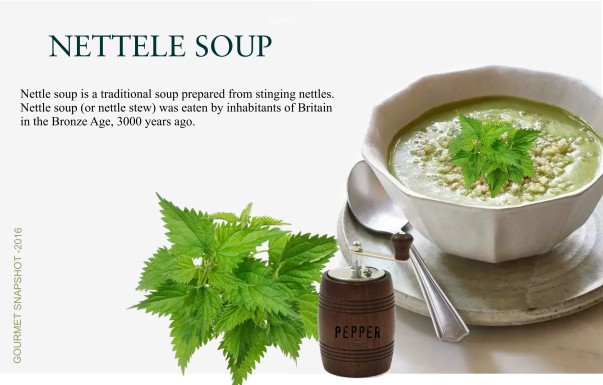
TODAY WE DID NOT FIND THIS FOOD IN THE OLDEST PUBS IN LONDON
SAUSAGES
The manufacture of sausages began over two thousand years ago. The first recognizable mention of sausage is found in a Greek play called “The Orya,” or “The Sausage,” written about 500 B.C.
The modern word “sausage” comes from Old French “saussiche”, which is derived from the Latin word “salsus” , which means ‘to prepare by salting.’ It was a favorite food of the Romans. During the reign of the Roman emperor Nero, sausages were associated with the Lupercalia festival, possibly the oldest festival known. Early in the 10th century during the Byzantine, The Romans, when they occupied Britain they brought with them this dish.
Also, the historical archives say that, this dish has been brought by Romans to Britain some time before 400 AD.
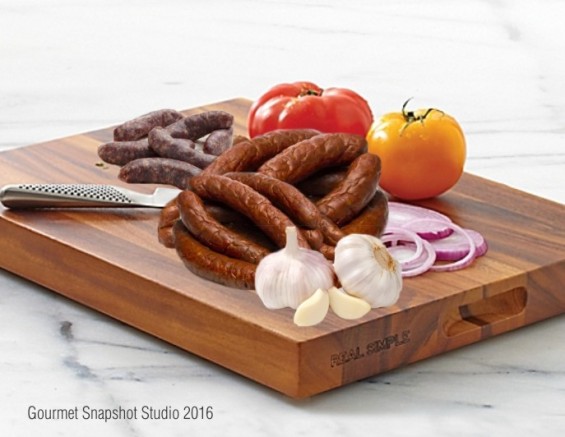
After the Second World War, this dish gets a specific English menu : Bangers & Mash, which is considered as a basic food for pubs. Today, Bangers & Mash or Sausages and Mash can be found in almost all pubs in London
TODAY WE FOUND THIS PREPARATION COOKED AS SAUSAGES & MASH IN THE OLDEST PUBS IN LONDON
